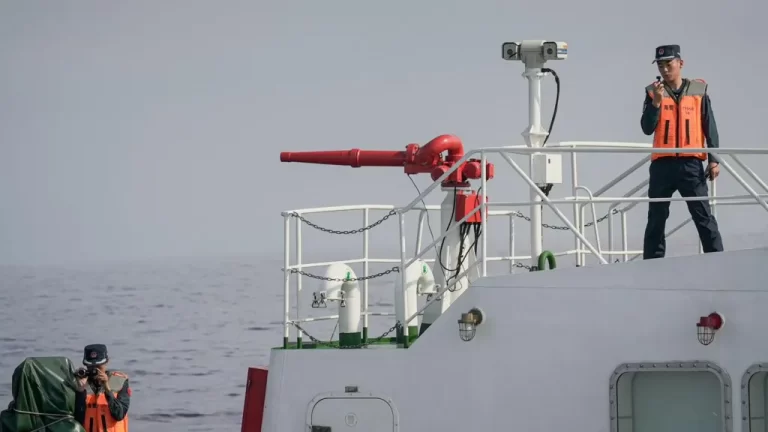We could see the larger Chinese ship moving closer, both our ships going at high speed. The Chinese crew were close enough for us to see their faces. Two of them filmed us, as we filmed them.
The BBC was onboard the Philippines coast guard vessel BRP Bagacay when it was accosted by Chinese vessels on Tuesday.
Filipino crews raced to hang yellow foam barriers over the side, preparing for a collision. Suddenly the Chinese ship made a sharp turn across our bow, forcing the Filipino captain to slow down abruptly. The two vessels were less than five metres apart.
We were racing towards Scarborough Shoal, a tiny coral atoll 220km (137 miles) west of the Philippines coast, but also claimed by China.
The Chinese ships were determined to stop us, and there were a lot of them – at one point of time there were 10 of them from the coast guard and maritime militia. The Filipino captain relied on the speed and manoeuvrability of his Japanese-made ship to outrun the Chinese, and got to within 600m of the shoal, the closest yet, he told us.
But there was a new barrier installed recently by the Chinese, just visible under the water. Their ships were right behind us, two positioning themselves on either side of the Filipino ship, at which they began firing their powerful water cannon.
We were rushed inside, from where we could hear the jets of water thundering against the metal walls of the ship. They smashed the awning in the stern, and mangled a railing on one side. The second ship in our convoy, carrying supplies for Filipino fishermen, was more badly damaged, after taking 10 direct hits from the water cannon.

This game of maritime cat-and-mouse is nothing new in the South China Sea. But these encounters have become more frequent, and more serious, since President Bongbong Marcos authorised the coastguard to challenge the Chinese presence in disputed areas far more robustly than in the past.
“The Chinese government has always said there is a red line”, said Commadore Jay Tarriela, the coast guard spokesman for the West Philippines Sea, the Filipino name for the areas it claims.
“They said we could not cross the 12 nautical mile limit from the shoal. But under this administration we have already broken that red line, to show that China is not respecting international law.”
The mission we were on is a part of that stronger response.
Officially its goal was to supply food and fuel to the Filipino fishermen who have worked on Scarborough Shoal for decades, but who have complained of constant harassment since the Chinese coast guard took control of it in 2012.
It was also to demonstrate the determination of the Philippines to press its claim to the shoal, which lies within the country’s legally-recognised exclusive economic zone, and is much close to the Philippines than to China.
An international court ruling in 2016 said major elements of China’s claims in the South China Sea —such as its nine-dash line along with a number of activities in Philippine waters—were unlawful. China says it does not recognise the ruling.
The numbers of Chinese ships visible around the shoal were intimidating. We could see them in every direction, hugely outnumbering anything that the Philippines can deploy.
“We are David to their Goliath,” said Commadore Tarriela.

It is difficult to see where this new policy of President Marcos will lead, though he has been given strong backing by US President Joe Biden, and has scaled up a long-term modernisation programme for the armed forces.
The Chinese ships were clearly skilled in their tactics, risky though they were. They can probably maintain their blockade almost indefinitely. After our encounter with their vessels, China put out a statement that it had successfully driven out the Filipino ships, which it accused of entering its territorial waters.
It is true that the BRP Bagacay did pull back from Scarborough Shoal after being battered by water cannon from two sides. The second vessel, with the supplies and with much of its electronic equipment damaged, was still hemmed in by Chinese ships more 20km behind us, so our ship returned to assist it.
But both ships stayed at sea, outside China’s “red line” but still well within its infamous “nine-dash line”, delineating its expansive claim to almost the entire South China Sea.

By morning dozens of fishing boats were gathered around us to receive their aid. From a distance a Chinese coast guard ship kept watch. With what they see as China’s bullying tactics once again exposed, the Philippines coastguard views this mission as successfully accomplished.


